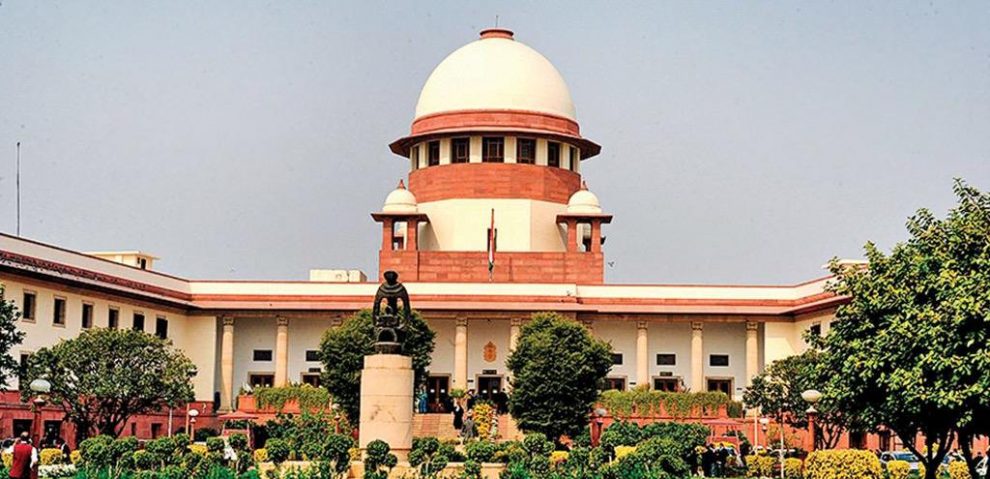AD-HOC JUDGES TO CLEAR BACKLOG
As lakhs of cases remain pending in high courts across India, the Supreme Court paved the way for the appointment of retired judges as ad-hoc judges to clear the judicial backlog. The order came on a PIL filed by ‘Lok Prahari’ seeking the appointment of ad-hoc judges to clear the pendency of cases.
A Bench headed by Chief Justice of India SA Bobde laid down guidelines for the appointment of ad hoc judges in high courts under Article 224A of the Constitution to deal with judicial pendency of specific categories of cases.
Those appointed as ad-hoc judges would get emoluments and allowances on a par with a permanent Judge of that court minus the pension, the top court ordered. Ad hoc judges will be entitled to allowance/perks/perquisites as available to permanent/additional Judge(s), it added. Their tenure may vary on the basis of the need but generally, it should be for two to three years, it said.
The top court asked the Union Law Ministry to act in tandem with high courts and submit a progress report to it in four months when it will take up the matter again.
The Chief Justice of a High Court may initiate the process of recommending a name if the judges’ vacancies are more than 20 per cent of the sanctioned strength, cases in a particular category are pending for more than five years, more than 10 per cent of pending cases are more than five years old, or the rate of disposal is lower than the filing of the cases either in a particular subject matter or generally in the court, the top court said.
The ‘ad-hoc judges’ appointments would follow the procedure laid down in the Memorandum of Procedure for appointment of judges and since the nominees were former judges their names need not be sent to the IB or other agencies for clearance, it said.
Article 224A reads as under:
“224A. Appointment of retired Judges at sittings of High Courts- Notwithstanding anything in this Chapter, the Chief Justice of a High Court for any State, may with the previous consent of the President, request any person who has held the office of a Judge of that Court or of any other High Court to sit and act as a Judge of the High Court for that State, and every such person so requested shall, while so sitting and acting, be entitled to such allowances as the President may by order determine and have all the jurisdiction, powers, and privileges of, but shall not otherwise be deemed to be, a Judge of that High Court: Provided that nothing in this article shall be deemed to require any such person as aforesaid to sit and act as a Judge of that High Court unless he consents so to do.”
The Court stated that
“ 23. The data placed before us, as drawn from the National Judicial Data Grid (“NJDG”) shows that five (5) High Courts alone are responsible for 54% of the pendency of over 57,51,312 cases – the High Courts of Allahabad, Punjab & Haryana, Madras, Bombay, and Rajasthan. The Madras High Court has among the highest arrears in the country of 5.8 lakh cases despite having fewer vacancies than most other High Courts (i.e., 7%). This does not take away from the requirement of appointing ad hoc Judges but supports the view that even if the existing vacancies are few, a situation may arise requiring the expertise of experienced Judges to be appointed as ad hoc Judges. On the other hand, Calcutta High Court has one of the highest vacancies of regular appointments (44%) but less than half the arrears as compared to Madras (2.7 lakh cases). In such a scenario, it is apparently the absence of strength of the Judges which may be responsible for creating the arrears and, thus, giving rise to another scenario for the appointment of ad-hoc Judges. In Punjab & Haryana High Court, which has a vacancy problem, the arrears have more than doubled over the last six years. The NJDG data shows that 56.4% of pending cases were filed within the past five years whereas 40% of the pending cases were filed between 5 to 20 years ago. The primary purpose of appointing ad hoc Judges is to deal with the latter group of cases that have been pending for over five years. [3]“
-
62 % cases are pending between 0 – 1 Years
-
76 % of cases are pending between 1 to 3 years.
-
6% of cases are pending between 3 to 5 years.
-
29 % of cases are pending between 5 – 10 years
-
5% of cases are pending between 10 -20 years.
-
63% cases are pending between 20 -30 years and
-
6% of cases are pending beyond 30 years.
The Court recalled that,
“ 32. The path we seek to traverse is supported by the Law Commission Reports. In fact, the 124th report of the Law Commission delivered in 1988 dealt with the aspect that a fresh look was required for High Court arrears. In that context, it has been recognized that retired judges have several decades of adjudicatory experience, and their talents could be utilized to dispose of mounting arrears. On account of their experience, they would be quick in disposing cases and being unburdened with administrative or admission work, they could spend their entire time hearing old matters. Thus, the appointment of retired judges as ad-hoc judges was seen as a part of a “multi-pronged attack” on arrears and was strongly recommended.”
The Court stipulated the following guidelines:-
Guidelines
A. Trigger Point for activation
Para 53. The discretion of the Chief Justice of the High Court under Article 224A is not constrained but as stated, some general guidelines are required to be laid so that power conferred under the said provision is exercised in a transparent manner. The Trigger Point cannot be singular and there can be more than one eventuality where it arises-
-
-
- If the vacancies are more than 20% of the sanctioned strength.
- The cases in a particular category are pending for over five years.
- More than 10% of the backlog of pending cases are over five years old.
- The percentage of the rate of disposal is lower than the institution of the cases either in a particular subject matter or generally in the Court.
- Even if there are not many old cases pending, but depending on the jurisdiction, a situation of mounting arrears is likely to arise if the rate of disposal is consistently lower than the rate of filing over a period of a year or more.
-
B. Embargo Situation
Para 54: We have already observed that the recourse to Article 224A is not an alternative to regular appointments. In order to emphasise this aspect, we clarify that if recommendations have not been made for more than 20% of the regular vacancies then the trigger for recourse to Article 224A would not arise.
Para 55: In this behalf, we may take note of the data placed before us which would suggest that there are only ten High Courts having fewer than 20% vacancies as of 1.4.2021; seven High Courts having fewer than 10% vacancies in permanent appointments but then there may be additional Judges and there are cases which are in the pipeline. Thus, the parameter we have adopted is that, at least, the recommendations should have been made leaving not more than 20% vacancies in order to take recourse to Article 224A.
C. Pre-recommendation process
- Past performance of recommended in both quality and quantum of disposal of cases should be factored in for selection as the objective is to clear the backlog.
- The Chief Justice should prepare a panel of Judges and former Judges. Naturally, this will be in respect of Judges on the anvil of retirement and normally Judges who have recently retired preferably within a period of one year. However, there can be situations where the Judge may have retired earlier but his expertise is required in a particular subject matter. There may also be a scenario where the Judge(s) may prefer to take some time off before embarking upon a second innings albeit a short one. In the preparation of the panel, in order to take consent and take into account different factors, a personal interaction should be held with the Judge concerned by the Chief Justice of the High Court.
D. Methodology of Appointment
Para 56: We have already noticed that para 24 of the MoP lays down a procedure for appointment under Article 224A of the Constitution. We have also noticed that it is not law laid down on this behalf under Article 141 of the Constitution but as a first step, it may be more appropriate to follow this procedure laid down in para 24 of the MoP to see the progress made and impediments, if any. We may however notice that since the Judges are already appointed to the post through a warrant of appointment, the occasion to refer the matter to the IB or other agencies would not arise in such a case, which would itself shorten the time period.
E. Time to complete the process
Para 57: The requirement that recommendations should be made six months in advance by the Chief Justice of the High Court emanates from the concept that the said period should be required to complete the process in case of a regular appointment of a Judge under Article 217 or 224 of the Constitution of India. In view of a number of aspects not required to be adverted to for appointment under Article 224A, we are of the view that a period of about three months should be sufficient to process a recommendation and, thus, ideally, a Chief Justice should start the process three months in advance for such appointment.
F. Tenure of Appointment
Para 58: The tenure for which an ad hoc Judge is appointed may vary on the basis of the need but suffice to say that in order to give an element of certainty and looking to the purpose for which they are appointed, generally the appointment should be for a period between two to three years.
G. Number of Appointments
Para 59: We are also of the view that, at least, for the time being dependent on the strength of the High Court and the problem faced by the Court, the number of ad hoc Judges should be in the range of two to five in a High Court.
H. Role of ad hoc Judges
Para 60: The primary objective being to deal with long-pending arrears, the said objective will be subserved by assigning more than five-year-old cases to the ad hoc Judges so appointed. However, this would not impinge upon the discretion of the Chief Justice of the High Court, if exigencies so demand for any particular subject matter even to deal with the cases less than five years old, though the primary objective must be kept in mind.
Para 61: One of the issues raised is of the constitution of Benches of an ad hoc Judge and sitting Judge in matters to be heard by Division Bench and as to who would preside. We are of the view that the Division Bench, at present, maybe constituted only of ad hoc Judges because these are old cases that need to be taken up by them. We also make it clear that because of the very nature of the profile and work to be carried out by ad hoc Judges, it would not be permissible for an ad hoc Judge to perform any other legal work whether it be advisory, of arbitration or appearance.
I. Emoluments and Allowances
Para 62: We have already discussed in the substantive part of the order that the emoluments and allowances of an ad hoc Judge should be at par with a permanent Judge of that Court at the relevant stage of time minus the pension. This is necessary to maintain the dignity of the Judge as also in view of the fact that all other legal work has been prohibited by us in terms of the aforesaid guidelines.
Para 63: We also make it clear that emoluments to be paid would be a charge on the Consolidated Fund of India consisting of salary and allowances. We may also clarify that it is a misconceived notion that there will be an additional burden on the State Government if some perquisites are made available to ad hoc Judges by the State Government. The trigger for the appointment of ad hoc Judges is the very existence of vacancies and had these vacancies been filled in, the State Government would have incurred these expenses anyhow. In any case there is a limit placed on the number of ad hoc Judges and, thus, the existence of vacancies actually results in the savings for the State Government(s), which would otherwise be amount expended as their allowances and perks.
Para 64: We make it clear that when we refer to allowance/perks/perquisites all benefits as are admissible to the permanent/additional Judge(s) would be given to the ad hoc Judge(s). For clarity, we may say that as far as housing accommodation is concerned, either the rent-free accommodation should be made available or the housing allowance should be provided on the same terms and conditions. For all practical purposes, the ad hoc Judge would receive the same emoluments, allowances and benefits as are admissible to the permanent/additional Judges. We may note that the Second Schedule, Part D of the Constitution of India stipulates the emoluments and benefits that have to be conferred on the judges of the Supreme Court and of the High Courts.
CONCLUSION
In conclusion, the Court said that
“ 65. We have taken the first step with the hope and aspiration that all concerned would cooperate and retiring/retired Judges would come forth and offer their services in the larger interest of the Judiciary. The guidelines cannot be exhaustive and that too at this stage. If problems arise, we will endeavour to iron them out. We must set aside apprehensions, if any, to chart this course and we are confident that there will be a way forward.
66. In view of the requirements of a continuous mandamus to see how a beginning has been made, list after four months calling upon the Ministry of Justice to file a report in respect of the progress made”.
 ABOUT THE AUTHOR
SANJAY CHAVRE
Mechical Engineer with MBA; LL.B ( First Semester) in Maharshi University of Information Technology, Maharshi Law School , NOIDA.
He retired in Aug 2020 as Senior Development Officer in Ministry of Heavy Industry, Govt of India . Previously he was in charge of investment promotion and international cooperation between Europe and India in the Ministry of Industry and Commerce. Mr. Chavre has more than 37 years of work experience in the Government mostly in technology/ industrial development and promotion. He has been focal in raising institutions of industrial infrastructure and technology development in diverse fields like locks, stones, machine tools, auto components, tool rooms, Environment management facilities, quality & productivity improvement, manufacturing technology etc.
ABOUT THE AUTHOR
SANJAY CHAVRE
Mechical Engineer with MBA; LL.B ( First Semester) in Maharshi University of Information Technology, Maharshi Law School , NOIDA.
He retired in Aug 2020 as Senior Development Officer in Ministry of Heavy Industry, Govt of India . Previously he was in charge of investment promotion and international cooperation between Europe and India in the Ministry of Industry and Commerce. Mr. Chavre has more than 37 years of work experience in the Government mostly in technology/ industrial development and promotion. He has been focal in raising institutions of industrial infrastructure and technology development in diverse fields like locks, stones, machine tools, auto components, tool rooms, Environment management facilities, quality & productivity improvement, manufacturing technology etc.












Add Comment